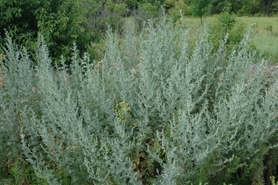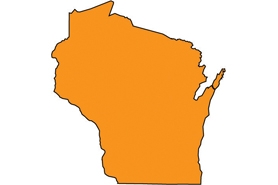Wormwood
(Artemisia absinthium)
A fragrant perennial herbaceous plant with a woody stem. The fragrance resembles that of garden sage.
Other names for this plant include:
- Common names: artemisia, absinth sage, absinth wormwood, absinth sagewort, common sagewort, absinthe mugwort, absinthium
- Scientific names: Artemisia absinthium var. absinthium; Artemisia absinthium var. insipida
Classification in Wisconsin: Restricted
- Ecological Threat
-
- Invades coniferous and hardwood forests, prairies, meadows, grasslands, fields, and disturbed areas.
- Viable seeds have been found in undisturbed grassland prairies.
- Plants are prolific seed producers.
- It is naturalized throughout much of the United States.
- It alters the flavor of milk when cows consume the plant.
- Chemical compounds may inhibit the growth of some surrounding plant species while stimulating the growth of others.
- Identification
-
Leaves & stems: Leaves are light green-greyish and covered in fine, silky white hairs. Deeply pinnately divided with round lobes/edges. The fragrance is similar to garden sage. Stems are somewhat woody.
Flowers: Small tubular flowers borne on dangling and dropping stalks form yellow clusters.
Fruits & seeds: Light brown seeds are shaped like sunflowers seeds, broader at the base and more narrow at the tip.
Roots: Plants have central taproots as well as long-branching lateral roots. Plants are mildly rhizomatous.
Similar species: Wormwood resembles many other species in the genus Artemisia, some of which are of particular concern and others are introduced non-natives:
Artemisia ludoviciana [native] – Leaves are lance-shaped and undivided (with few to no lobes). Artemisia serrata [native] – Lance-shaped slender leaves have toothed edges. Artemisia frigida [native, particular concern]. Artemisia dracunculus [native, particular concern] – Flower heads are erect, not nodding like the invasive A. absinthium.
For more identification information, visit the Wisconsin State Herbarium link under the resources tab.
- Control
- Mechanical:
- Dig up individual plants. For larger populations, mow as close to the ground as possible. Monitor for re-sprouts.
- When leaves emerge, cover the infestation with black landscape fabric/plastic in early spring. Keep covered for a minimum of one growing season.
- With sufficient fuel loads, consecutive prescribed burns are also a successful control option.
- Picloram, dicamba, 2,4-D, and glyphosate are all effective herbicides. Follow the recommended label rates.
- Resources
- Sources for content:
- Carey, Jennifer H. 1994. Artemisia absinthium. In: Fire Effects Information System, [Online]. U.S. Department of Agriculture, Forest Service, Rocky Mountain Research Station, Fire Sciences Laboratory (Producer). [2013, August 12].
- University of Wisconsin - Stevens Point, Robert W. Freckmann Herbarium
- Center for Invasive Species and Ecosystem Management; invasive.org


